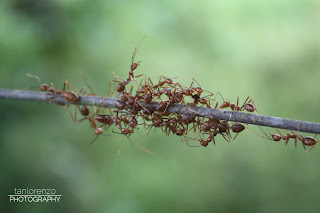Ants are social insects of the
family Formicidae (pron.: /fɔrˈmɪsɨdiː/) and, along with the related wasps and
bees, belong to the order Hymenoptera. Ants evolved from wasp-like ancestors in
the mid-Cretaceous period between 110 and 130 million years ago and diversified
after the rise of flowering plants. More than 12,500 out of an estimated total
of 22,000 species have been classified.[3][4] They are easily identified by
their elbowed antennae and a distinctive node-like structure that forms a
slender waist.
Ants form colonies that range in
size from a few dozen predatory individuals living in small natural cavities to
highly organized colonies that may occupy large territories and consist of
millions of individuals. Larger colonies consist mostly of sterile wingless
females forming castes of "workers", "soldiers", or other specialized
groups. Nearly all ant colonies also have some fertile males called
"drones" and one or more fertile females called "queens".
The colonies sometimes are described as super organisms because the ants appear
to operate as a unified entity, collectively working together to support the
colony.






No comments:
Post a Comment